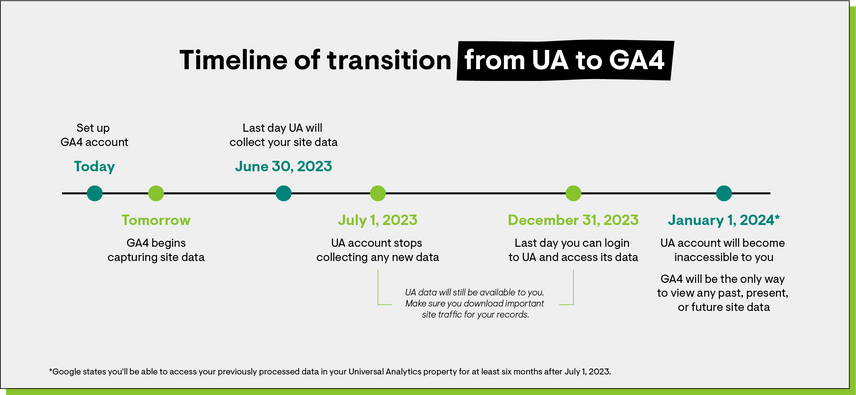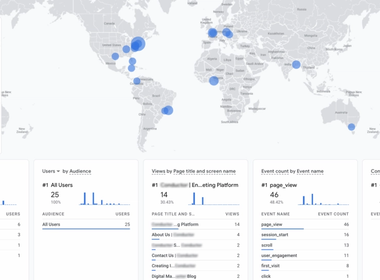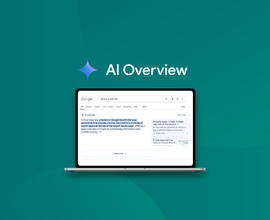What You Need to Know About GA4 and What to Do About It
What’s happening to Google Analytics?
Google has launched a new version of its analytics platform called Google Analytics 4 (GA4).
According to Google , GA4 is better for companies and users because it:
- Is focused on privacy and built to last.
- Uses intelligent machine learning to “unearth insights about the customer journey across platforms and devices.”
- Offers “enhanced, seamless integrations with Google’s advertising platforms to optimize campaign performance and drive greater marketing ROI.”
The most significant change will be the way Google tracks and ingests data . Where data collection previously used “hits” such as page hits, event hits, eCommerce hits, and social interaction hits, GA4 uses events, where each user interaction can be captured as an event.
Events-based data collection allows for two key improvements to the site analytics platform :
- Better conversion tracking. Because you can track each interaction as an event, those events can be used more effectively to chart out the user journey and determine the path to conversion across each channel. It can even include conversions from YouTube. This can help you better assess the cumulative impact of your various marketing efforts.
- Better understanding of the consumer life cycle. Event-based tracking allows for more customer-centric measurement and analysis, capturing the full user experience rather than segmented user experiences across individual devices or mediums. This allows for better tracking across users’ entire life cycles, from acquisition to conversion to retention.
What’s the impact of the transition to GA4?
There are two major implications of this update that marketers, data analysts, website owners, CMOs, and anyone who touches your website should be aware of:
Sunsetting and removal of UA
Google will sunset the current version of its analytics platform, known as Universal Analytics (UA). Eventually, it—and the data you’ve collected with it—will be completely unavailable to users on Google.
Your Standard UA properties will stop collecting new data on July 1, 2023. Initially, you will be able to access site data collected through June 30, 2023, for an additional six months. However, after that, Google will no longer make UA site data accessible.
Note that as of October 2022, Google Analytics 360 will now only stop collecting new data on July 1, 2024 . The previous timeline ended data collection on October 1, 2023 but it has been extended. This is hardly surprising as Google Analytics 360 accounts are primarily used by enterprise businesses, as a paid platform that contains additional tools and support, which would be more likely to face struggles transitioning their larger-scale accounts to GA4.
UA data cannot be merged into GA4
Unfortunately, none of the data from your existing UA account—including all traffic and customizations—will be transferable to your new account, as of the publication of this piece. While it’s possible that this may change or that there may eventually be some exceptions, it’s safer to work under the assumption that no data or custom settings will automatically transfer.
At least 6 months after UA properties are sunset (i.e., January 1, 2024), GA4 will be the only way to access your website’s data using Google Analytics. What’s more, your available data in GA4 will go back only as far as when you configured your GA4 account.
So if you set up your GA4 account on June 14, 2022, you likely won’t have your first full day of data in GA4 until approximately June 16, 2022. And after UA data becomes inaccessible, all of your site data in Google Analytics will start on June 16, 2022.
Prior to UA data being deactivated, you can download your historical UA data. It’s unlikely that you’ll be able to export everything you might need. And, even if you could, it would be too much data to actually be able to use.
So, carefully consider which reports will be most helpful to have on hand, and include your most regularly used data, relevant time frames, various daily, weekly, and monthly breakouts, segments, etc. Think ahead to the historical data you’ll want to look at in a month, a quarter, or a year from now and how you can export UA data in a way that will be usable in the future.
Changes to the interface and pre-built reports
Since GA4 takes a different approach to data collection and provides a range of new services, the platform’s reporting capabilities will look different.
The format of the many reports you currently use has likely changed. In some cases, Google may have moved or altered reports or report settings. In other cases, there may be no analogous features in the Google Analytics 4 property.
The upside is that there are new customization features that allow you to recreate some of the standard UA reports that you’re used to working with and create your own reports from scratch.
What do I need to do now?
SET UP GA4 IMMEDIATELY.
Since UA data will eventually become inaccessible and cannot be migrated, the day you set up GA4 will be the first day of data that you’ll have access to once UA is out of the picture—as explained in the June 14 example above.
Delays will prevent you from year-over-year tracking
The timing is especially important because if you set up your GA4 account after June 30, 2022, come July 1, 2023, you won’t have a full year’s worth of data in GA4 before UA stops collecting data. If your first day of complete data collection is August 15, 2022, you won’t be able to conduct YoY analysis until August 15, 2023.
The good news is that you can have UA and GA4 capturing site data simultaneously, so you’ll be able to maintain full usage of UA and your customization while also collecting and familiarizing yourself with GA4.
The process for adding GA4 to your site should be straightforward. In your UA account, you’ll see a prompt to start the setup, which will help you through it. It’ll provide a snippet of code, similar to what is currently on your site that lets UA function properly that you or your webmaster can add to the header of your site to ensure the data gets populated into GA4.
Auto-migration vs. manual migration
Google has announced that for any user who hasn’t completed setup of a GA4 property by March 2022, they will automatically configure one with a few basic settings aligned with the existing Universal Analytics property. However, it will only include certain conversionConversion
Conversions are processes in online marketing that lead to a defined conclusion.
Learn more events, Google Ads links, and existing website tags—which is unlikely to be sufficient for most businesses with more than just a basic website.
Keep in mind that not all UA configurations have a direct GA4 counterpart, and you or someone in your organization would have a better sense of what’s right for your needs than the automated process. Even Google strongly recommends manual migration of your Universal Analytics settings to GA4. Check if you’ve been auto-migrated already, with the option to delete your automatically configured Google Analytics 4 property if you prefer a more comprehensive migration.
The good news is that for a limited time, Google is providing free Google Analytics 4 setup sessions with a specialist for certain users that qualify (e.g., have UA properties that contain conversions and/or audiences that will require custom Google Analytics 4 setup). Check your email to see if Google has reached out to you about this exclusive offer.
What do I need to do in the long term?
Before Google sunsets UA, download all of your appropriate historical data. Take time to determine your long-term data needs and what is worth carrying over.
Run a full audit of all your UA customizations outside of your downloadable data. Ensure you have a record of each component, including custom events, custom segments, conversion tracking and metrics customizations, any custom filters, acquisition channels, reports, charts, user permissions, etc., because these cannot currently be transferred over automatically.
Because you can configure these customizations in GA4 after you’ve integrated the GA4 tracking code on your site, it’s worthwhile taking some time to reconsider your objectives for your customizations.
Have your marketing and analytics team members consider whether you are making the best use of the data you’ve been collecting so far. Is there anything you’re not tracking or could be tracking more effectively? Does the data come together to tell a holistic story about your consumer’s experience with your site? And does that data help inform site optimizations?
The transition to GA4 is a great time to reevaluate the answers to these questions and change how you track engagement with your site.
Be sure to double-check any limits on customizations and align your plans accordingly.
For additional support and recommendations on this topic, check out Google’s articles about how they’ve improved acquisition reporting, review the events they automatically begin to track when you set up GA4, and custom reports ideas for how they recommend capturing and visualizing the conversion funnel.
Timeline for GA4 Transition
Here’s a recap of the important dates related to GA4 set up and UA sunsetting as well as the implications of the shift on your site data.

What does this mean for my Conductor integration?
Conductor’s GA4 integration is available to all customers, and well before Google sunsets their support for Universal Analytics so users have ample time to adjust to the new data in Conductor’s platform.
Conductor’s integration also provides some unique advantages to address key pain points around the transition to GA4. If you’ve already been tracking UA in Conductor, you can rest assured that your data will be stored and easily accessiblecan track multiple integrations after Google deactivates UA on their end. Additionally, you for the same domain and rank source, so you can view and compare the same SEO reports between UA and GA4 as a way to build better understanding and familiarity with GA4.
Read more about Conductor’s GA4 integration here →
Given this, we recommend that you keep your UA account live to keep your integration with Conductor active. You can and should have UA and GA4 implemented on your site at the same time. Beside maintaining the integration, it will give you time to set up your customizations in GA4 while allowing UA to continue capturing data in your current setup, including any custom conversions and revenue tracking.
As always, the Conductor team recommends setting up your GA4 properties in addition to your UA properties as soon as possible. The earlier the better to have enough historical GA4 data to hit the ground running once UA is deprecated.
What if I need more information or assistance for my account?
Stay in touch!
Send us a message or chat us with questions. You can also sign up for our Dispatch Newsletter to receive email updates.
Reach out to your customer success representative for additional information and recommendations on how to get buy-in from your organization about the transition and setting up your GA4 account.
Check out and save this infographic for a compact and shareable summary of the key GA4 updates:

Stay tuned for our monthly 30|30 Webinars with Pat Reinhart where he covers the latest SEO and organic marketing updates, trends, and insights from the last 30 days. He first addressed this GA4 change back in April 2022 and will continue to provide updates relevant to website tracking and account management as they become available.
TL;DR action items and takeaways
- UA is going away, but keep it up and running for the time being.
- Implement GA4 ASAP, so it can capture data alongside UA.
- No data will be transferred or merged between UA and GA4.
- Therefore, update GA4 settings to reflect your custom needs, including custom events, conversions, and revenue tracking.
- By July 1, 2023, UA will no longer collect new data. But historical data will still be accessible for at least 6 months afterwards.
- To be safe, make sure you’ve downloaded your relevant site traffic from UA by December 31, 2023.
- It's estimated that by January 1, 2024, UA data will no longer be accessible and all site data will be available solely by GA4.
- The first date that GA4 collected data will be the earliest historical data that you have access to in the analytics platform.
- For Universal Analytics 360, new data will no longer be collected starting July 1, 2024 (as of October 2022).







